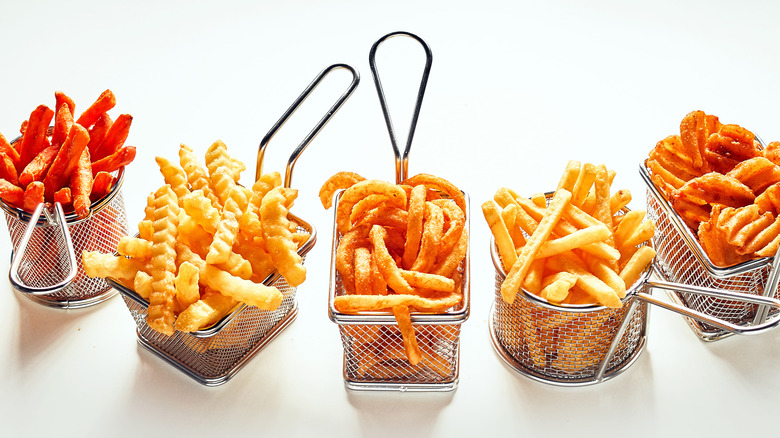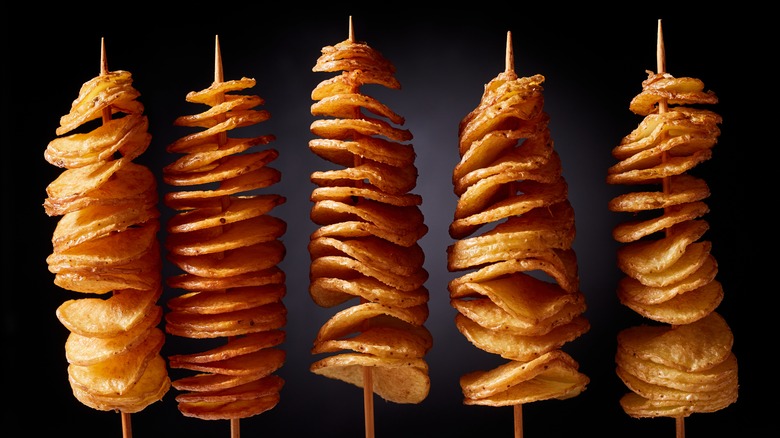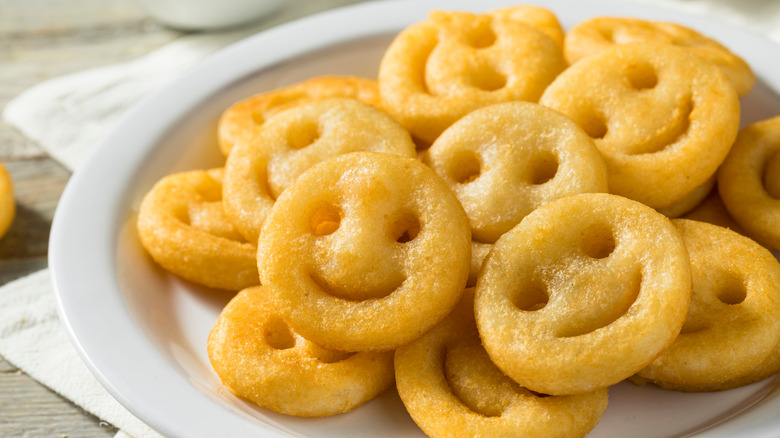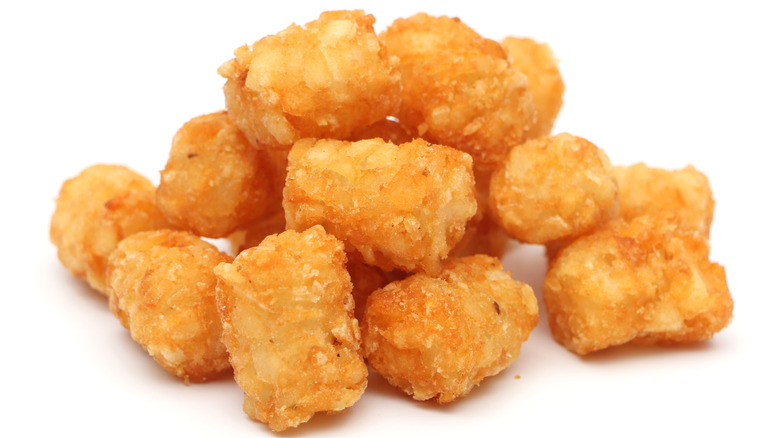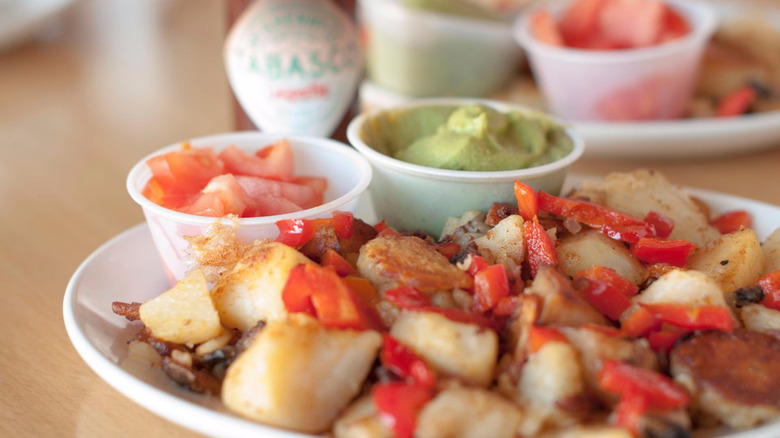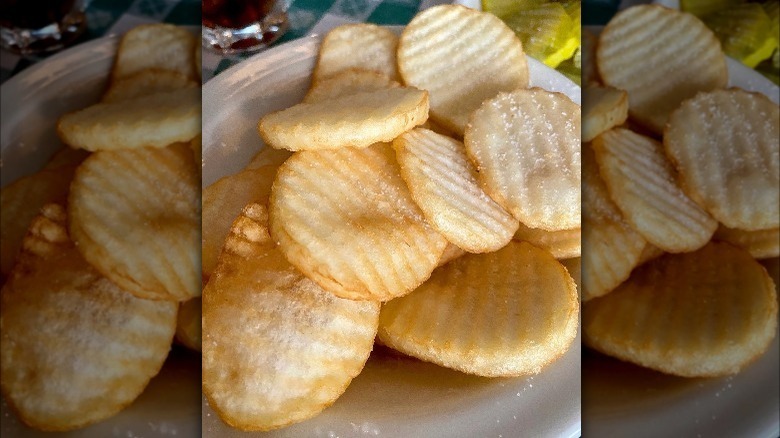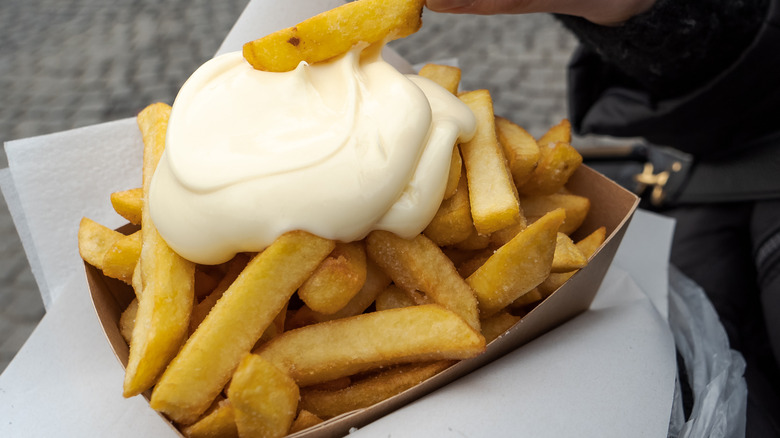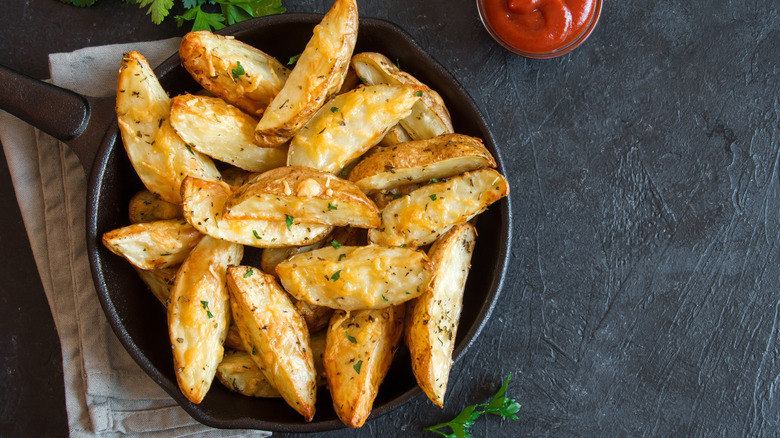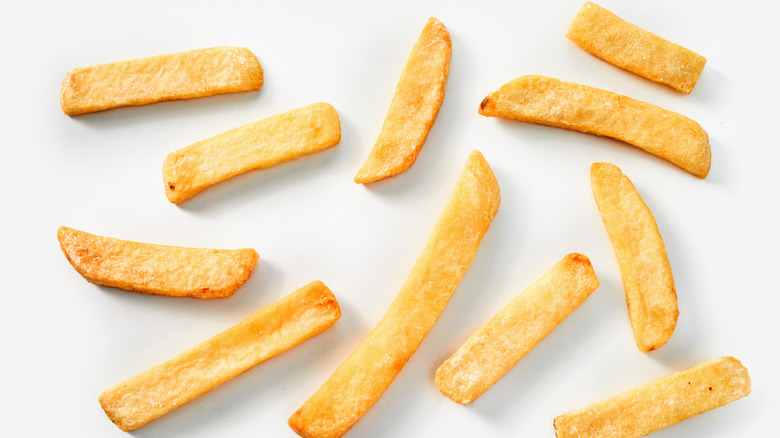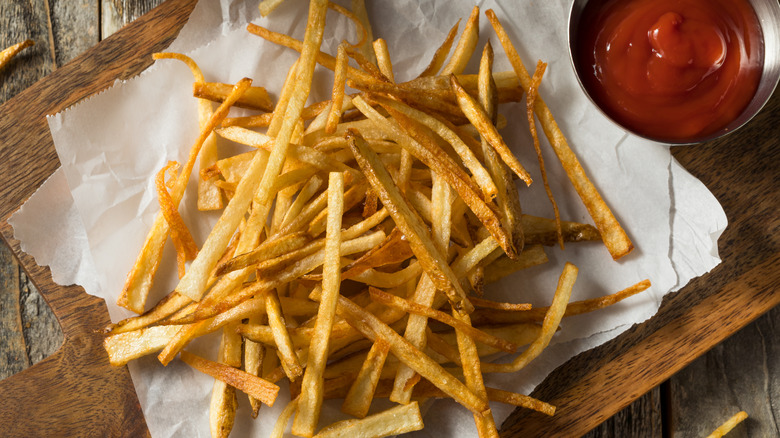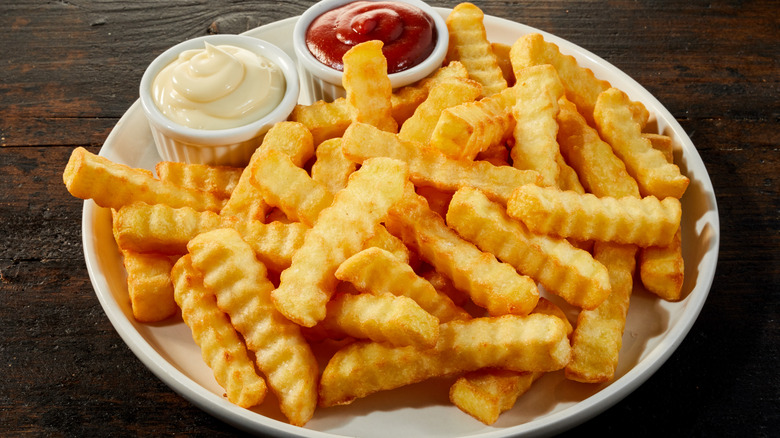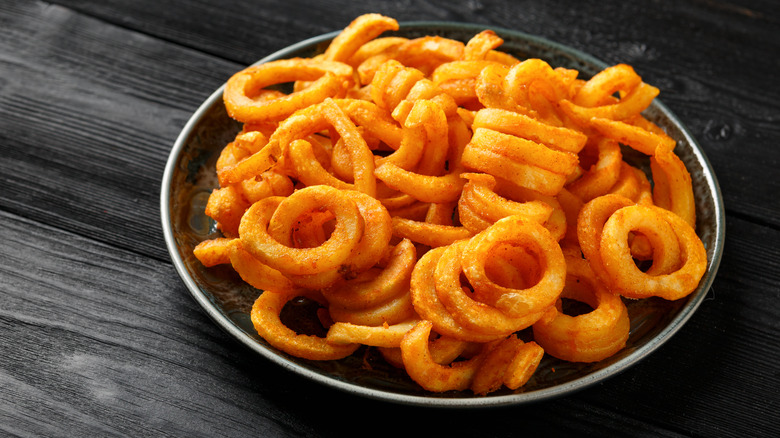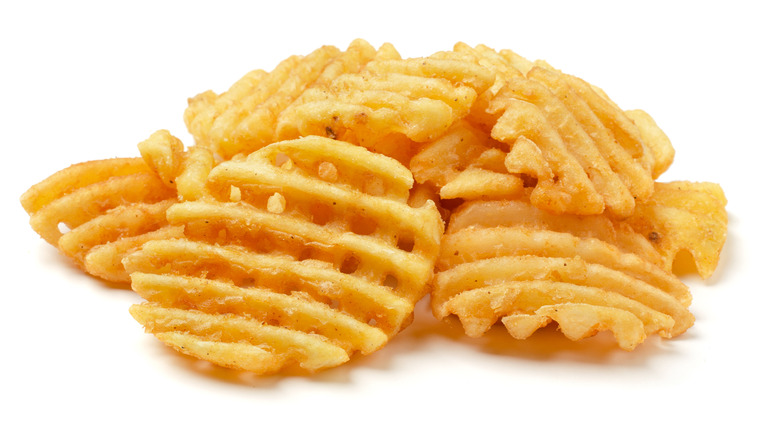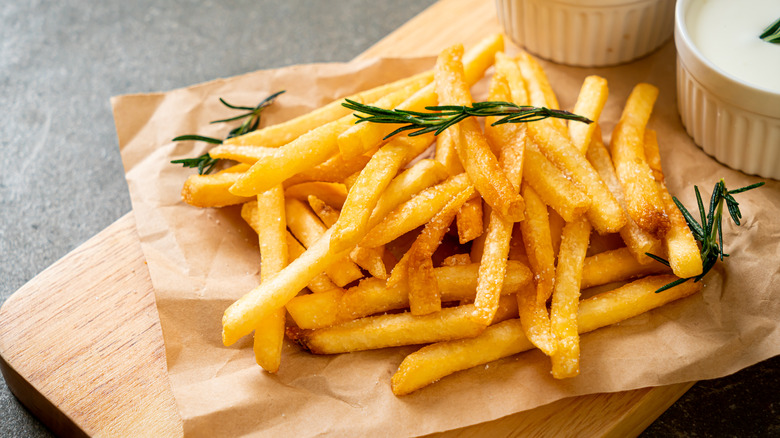Every French Fry Cut, Ranked Worst To Best
French fries have long been embraced by American cuisine (despite being stolen from overseas). In France, the French like to claim fries were invented by Parisian chefs who created the recipe just before the onset of the French Revolution, according to NY Daily News. In nearby Belgium, the Belgians also like to lay claim to the fry, even though the origin story there is less well-known, reports The Culture Trip.
Those that have been misled about fries' origins can also blame Americans. According to National Geographic, french fries got their name when soldiers from the U.S. went to France during World War I and tried the snack for the first time. There's also another explanation for the incorrect name: in Old English, "to cut lengthwise" translates to "to french," reports Expatica.
Fries are now available at almost every fast food chain in the states. From Wendy's to McDonald's to Burger King, there's an opportunity to get a side of fries. The food — simply made from pieces of potato that are fried and salted — is deliciously simple. But whether that potato is cut into zigzags, shaved into curls, or finely julienned into matchstick-size pieces, everyone has an opinion on which shape is the tastiest. When it all comes down to it, preference for french fry shape is usually based on how crispy, crunchy, and dippable a fry produced by a particular potato-cutting method tends to be. Here is every french fry cut, ranked worst to best.
14. Potato Tornado
Of those potato-cutting methods, the "potato tornado" is one of the most untraditional. Instead of individual fries, the snack consists of a whole potato that has been cut into a spiral shape and fried onto a skewer (via YouTube). Once fried, the entire potato attaches to the stick. This ingenious method then allows individual fries to be pulled off and enjoyed, making it the final process of eating a potato tornado a lot like enjoying a regular side of french fries.
Although it's very creative, the potato tornado isn't well-known or accessible enough to be ranked anywhere but dead last, unfortunately. Many people may have never even heard of the potato tornado. The snack has only recently gained traction in the U.S. over the past decade or so. The potato tornado has been popular for longer in South Korea, where it originated, according to NPR. Around 2009, pictures of the potato tornado went viral online, piquing America's interest. The snack then became a popular item at places like the Jersey Shore, the Press of Atlantic City reports. However, the ingenuity of this french fry cut earns it a place in the french fry cut ranking — even though that place is at the very end.
13. Potato Smiles
This potato cut is slightly better than the previous one because Potato Smiles come pre-cut into individual, bite-sized pieces. Although the smiley face-shaped fries are distinctly round — where standard french fries are long and slender — these tubular angles produce a satisfying texture. The curves of each Potato Smile give rise to a delicious crunchy shell, which covers a softer potato texture underneath. Potato Smiles are even small and easily handheld, enabling them to be dipped like a normal french fry. The fact that they're sold in the freezer aisle also makes them very accessible.
But Potato Smiles' unique shape means they aren't made like regular french fries. They're made from a mix of boiled mashed potatoes and binding agents like cornflour which contribute to their delicious variety of textures (via FlavourofFood). Even the most commonly found frozen Potato Smiles made by McCain are made with mashed potatoes, according to the company. Not only does this french fry cut look nothing like a regular french fry, but the process of making Potato Smiles makes them more like a thanksgiving side rather than a delicious fast food item. However, that doesn't mean they won't make you grin with every bite.
12. Tater tots
This beloved potato snack seems to be in a category all its own, but when you look again, tater tots are pretty much stubby little french fries. They're always crispy and dippable, earning them a well-deserved spot in this ranking. Tater tots (unlike french fries) are even a truly American invention: two Mormon brothers — F. Nephi and Golden Grigg — are credited with inventing them. They then went on to found the major frozen potato manufacturer Ore-Ida, which still sells tots today.
These short cylinders of potato are far closer in appearance and shape to your average fry, but they still fall a little short. Tater tots are traditionally frozen, which is not the best sign. They're also made more like hash browns — which many would not dare to call a french fry. According to New York Times Cooking, the tot-making process involves simply shredding, then pan-frying small handfuls of potato. While the tots are still extremely popular — with Americans eating around 70 million pounds annually (via the South Florida Reporter) — their cooking process makes them less fry-like. That's why tater tots are ranked near the bottom.
11. Sweet potato fries
Since the 1980s, these fries have been touted as a healthy alternative to their mainstream counterpart. In 2010, the New York Times reported that sweet potato fries were being recommended by doctors to diabetes patients, due to their nutritional benefits. Despite being viewed as healthier, sweet potato fries are usually just as high in calories as typical fries, Men's Health reports. But they can end up being healthier due to their tendency to be baked (meaning less oil). In addition to nutrition, they're also distinctly a cut of french fry, earning sweet potato fries a place in the ranking.
On the downside, these fries are not just a different cut, but a different potato. You're going to notice when a serving of bright orange fries shows up on your plate, instead of those gorgeously golden ones. They also tend to have issues when frying them, leading some sweet potato fries to end up soggy. The reason for this is that sweet potatoes contain "more sugar, more water, and less starch" than regular potatoes, according to Food 52. Because sweet potato fries sometimes need to be baked (via New York Times Cooking) to ensure their crispiness, their cooking process also knocks them down the list. Some would even argue that any potato snack that isn't sizzled in oil isn't a "fry" at all.
10. Home fries
Home fries are sometimes known by different names in the U.S., such as "house fries" or even "American fries." These names are acceptable. If ordered, they should all produce a plate of small, cubed potatoes. They're not to be confused with hash browns, which have an entirely different preparation and resulting shape, according to Southern Living. Unlike hash browns, this common diner order is certainly a winning cut of french fry.
Don't let the fact that these fries are served at breakfast confuse you. Even though home fries are usually eaten in the morning, they typically also act as the side to a protein. As tater tots are to frozen chicken nuggets, home fries are to sunny-side-up eggs. They're also traditional in their potato choice. Home fries are usually cut from your average potato, just like normal fries. Both home fries and french fries are typically made with Idahos or Russets (via The Bossy Kitchen). These breakfast potatoes are even prepared using similar methods to their stick-shaped cousins. To make home fries, potato pieces are cubed, par-boiled, and then pan-fried in oil, according to a recipe by The Kitchn.
Still, home fries have one major letdown: These fried potatoes are usually eaten with a fork. For requiring utensils, home fries are placed in the bottom half of the best french fry cuts.
9. Cottage fries
Cottage fries are the round and ridged fries that complement meals at famous burger joints such as New York's J.G. Melon. According to Food52, cottage fries are so-named to refer to the individual shingles on the roof of a cottage. Fortunately, this shingle-like shape allows them to dip or scoop up various sauces. Also on the plus-side, cottage fries contain a delicious duplicity of textures. As The Kitchn writes in their recipe, the potato pieces are "lightly crisped on the outside and super fluffy on the inside," similar to Potato Smiles' crunchy-yet-soft nature. However, cottage fries are better, because they are not made from mashed potatoes.
For the negative aspects of this french fry cut, the shape of cottage fries is untraditional. Cottage fries are essentially circles, whereas french fries are usually more like rectangles. For this reason, they'll place below the traditionally cut fries. Also, people tend to get these fried potatoes confused with home fries. It's a common mistake since both home and cottage fries are prepared the same way, according to Better Homes and Gardens. But any french fry shape that can be so easily confused shouldn't be a clear winner.
8. Belgian fries
These fries deserve a mention for their history, as well as their taste. According to Belgium, their country is the true inventor of french fries, not France. As their story goes, french fries originated in the Belgian city of Namur. The residents of Namur were obsessed with cooking up fried fish until their fishing spot froze in the winter of 1680. Instead, Namur natives fried some pieces of potato, and the french fry was born, BBC Travel reports.
In addition to authenticity, these french fries are a very satisfying snack. The recipe for Belgian fries adds an extra layer of extravagance. As International Cuisine explains in their recipe, a potato is first thickly sliced, then fried in animal fat instead of oil. Next, the slices are fried a second time in the fat. Last, the fries are served with rich-tasting andalouse sauce or creamy mayonnaise, according to The Daily Meal.
Although authentic, Belgian fries aren't even the best kind of thickly cut french fry. For one, if distinguished by their cut alone, there isn't much to them. If you looked at a plate of Belgian fries, it would be hard to distinguish them from a plate of steak fries. Add to that the fact that you'll be hard-pressed to find Belgian fries in the states, and there's another reason to keep Belgian fries around the middle tier of french fry cuts.
7. Potato wedges
Potato wedges are typically thick fries cut straight from an unpeeled potato. In some parts of the U.S, potato wedges are known by a different name. In the Pacific Northwest, they are also referred to as "jojo's." In the Bay Area, they're called "mojos." The fries are even popular in Australia, where they're called "Aussie Wedges." Along with name discrepancies, no one can seem to agree on who invented them, the Portland Tribune reports. Just like many other french fry shapes, potato wedges have their share of passionate, argumentative fans. And they should, since the satisfyingly fluffy and hefty fries are preferred by many.
The wedges are close to the steak fry shape, but a little more untraditional due to their skin-on qualities — which often lead to a less crispy fry. Also, they are sometimes baked, sometimes fried, or sometimes breaded like a chicken, according to the Seattle Times. Because of the inconsistencies with their name, origin story, and preparation, the potato wedge is among the middle of the thickly cut french fry cut — you just never know what you're going to get. They're neither the worst nor the best thick fry. Overall, these fries are closer to what's wanted in a cut than the aforementioned shapes, but not all the way there.
6. Steak fries
The term steak fries also refers to thick-cut french fries. Steak fries are approximately one centimeter thick, with an inside similar to that of a baked potato. They differ from the previous shape in a few obvious ways. Steak fries are served without potato skins. They're cut into rectangles, not wedges. They're also more likely to be made in a fryer, not the oven. For these reasons, steak fries are just a little better than potato wedges.
Steak fries are more like what the British call "chips" than Belgian fries or potato wedges. Although the comparison has been made, British chips are typically more wedge-shaped than steak fries, prepared with vinegar, and without their skins. Steak fries are also different from "steak frites," which refers to the French meal of a steak served with a side of french fries, according to Britannica. Despite its popularity worldwide, this cut's shape is too ubiquitous to make it the best. It's also far from the thinner, crispier fries that are desired by most french fry lovers. Maybe one day steak fries will be the peak fry shape, but that day is not today.
5. Shoestring fries
Arguably the most petite french fry cut is the shoestring. Although you may have heard this shape referred to as other names, including matchstick, straw, or julienne, they all indicate the same small fry. Shoestring fries are often associated with the Pik-Nik or Utz companies. Although the products made by these companies are more a potato chip than a french fry, their shoestring snacks exemplify what's best about this french fry cut: they are super thin and delicate.
According to National Day Calendar, there's even an American holiday dedicated to this fry type. August 12 is "National Julienne Fries Day," in case you didn't know. Their popularity makes sense, because shoestring fries are closer to the style of the classic fast food side. Matchstick fries are similar to the shape sold by McDonald's. However, they're a little too small for some people's taste. Also, this shape can sometimes lead to an unsatisfyingly small snack that will leave you wanting more fries. The shoestring shape can even cause the fries to be too soggy.
4. Crinkle-cut fries
Crinkle fries are a rare treat, as making them requires special tools and they're not sold by every fast food chain. Places like Shake Shack, Raising Canes, Del Taco, and Nathan's are some of the few companies to sell crinkle-cut fries. This shape is known for being underappreciated, but the fries have their share of fans. Shake Shack's patrons even revolted when crinkle-cut fries were briefly removed from the NYC chain's menu.
Duff Goldman, star of the Food Network's "Ace of Cakes," famously loves crinkle-cut fries. According to his Twitter, the fries usually end up soggy due to too-hot oil. This means crinkle-cut fries' hate comes from improper preparation. There's nothing essentially wrong with the shape, people may just be cooking them wrong.
In general, these textural problems are the source of their loathing. According to one crinkle-cut hater on Reddit, the reason this cut is the worst is that "the ridges are never crunchy, in fact mostly soggy because they are flawed to retain excess frying oil." This thread of crinkle haters includes the testimony that, "I don't know if I've ever had good crinkle-cut fries. Feels like they are always either soggy or hard, never in that crispy sweet spot." On this thread, one user argued "The crinkled are good if seasoned. If they're just bland, **** them." Clearly, these polarizing fries shouldn't be number one.
3. Curly fries
Like the previous shape, curly fries require certain instruments to be cut. To make those curls, the Food Network recommends using a vegetable spiralizer. More often than not, curly fries are also heavily seasoned, giving them their orangish hue. That seasoning is often likened to Cajun or Old Bay spices. One recipe recommends using ingredients like onion, garlic, cayenne, and paprika to make the authentic curly-fry flavor. According to The Daily Meal, this recipe is pretty standard. That's why curly fries taste consistently flavorsome wherever you order them.
Curly french fries are less despised than crinkle-cut, but — maybe, because of that — they've made less of a comeback. Aside from Arby's beloved menu item, curly fries are associated with bowling alleys and dive bars, reports GrubStreet. Like this reputation, the history of curly fries is just as underrated.
Overall, these salty, crunchy, exciting-looking fries are celebrated by many. However, the requirement of seasoning is doing too much work in this french fry. Take away that Old Bay flavor and the shape you're left with still isn't the best. It may be nostalgic, but curly fries are neither the best for dipping nor the most consistent. It's a noble fry, nonetheless.
2. Waffle fries
Waffle fries — sometimes referred to as lattice fries or gaufrettes — are a clear favorite. Unlike crinkle-cut fries, they're often crispy and crunchy. Unlike curly fries, they don't need a complicated seasoning to make them taste good. Chick-fil-A — a major fast food chain that is easily accessible, except on Sundays, of course — offers a great version of the fry. According to the University of Alabama's student-run newspaper, the waffle fries' construction is a genius, modern development in the history of french fries, that allows them "to hold the perfect amount of dipping sauce." That sounds pretty dippable.
On the negative side, making waffle fries requires a special device. Food and Wine recommends using a mandoline blade fitted with a "waffle blade" or "wave-waffle" cutter, then boiling and frying the potatoes in oil. For the lack of ease alone, waffle fries take the number two spot in the ranking of all-time best french fry cuts.
1. Standard fries
It's hard to find a better shape than the standard french fry cut. Somewhere between a steak fry and a shoestring fry is what most people want when they order the classic side. This shape is thin. It doesn't need to be fried twice. Most importantly, it's most likely to be crisp. Most of the time, the standard fry cut is bound to produce an easily made, dippable, accessible, nostalgic, and altogether quintessential french fry.
Even though new french fry trends like TikTok's mashed potato fries are created all the time, U.S. citizens are eating about 30 pounds each of the standard fries every year. These fries aren't coated in Old Bay flavors or made from sweet potatoes, they aren't shaped like a waffle or a smiley face, they aren't baked in the oven, they don't need to be cut using a fancy French cooking technique to be made, either — they are the classic french fry cut. All that's needed is a knife, some oil, and salt.
Since the first half of the 20th century, french fries have been available at fast food and other American restaurants all over the country. This slim, crunchy, and crispy type of french fry has persisted. It doesn't seem to be going anywhere soon.
